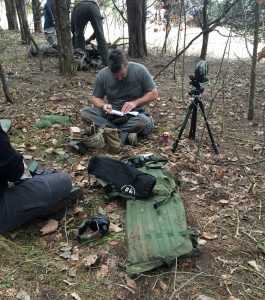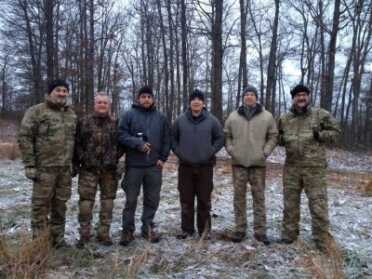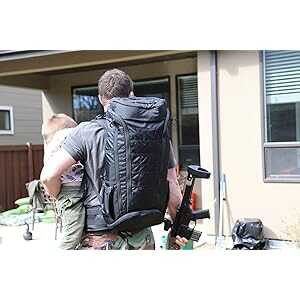
The author found the Mammoth Sniper Challenge, held at the Rockcastle Shooting Center and shot by two-man teams, to be a challenging test of his precision rifle skills.
For those who want to push themselves, their skills and their gear, then look no further than the Mammoth Sniper Challenge at the Rockcastle Shooting Center. A multi-day precision rifle shooting competition open to civilians, the challenge is designed to push your skills in long-range shooting to the test. The match is promised to be the toughest in the nation, and for my money they deliver. Based around two-person teams, I for one feel like my team absolutely got our entry fee’s worth of fun. It was also very much a year of learning and remembering. As with all the lessons I seem to learn, most of them were painful. Here is what I took from my first run at Mammoth.
Gas Guns vs. Bolt-Actions

The author and his partner chose to use LaRue Tactical OBR rifles in 7.62mm for the event. Image courtesy of LaRue Tactical.
Many military competitions are built to favor semi-auto guns (due to the speed of engagement), so I told my partner to borrow a LaRue Tactical OBR (Optimized Battle Rifle) in .308, matching my personal gun. You have to have a very, very good bolt-gun to beat an OBR on accuracy; my personal gun will hold a .7 MOA group, and I have shot some that will hold .5 MOA. If you are restricted to a non-magnum caliber, a semi auto offers many advantages. It also has a very few drawbacks.
I have been told civilian precision matches tend to favor bolt-actions. Against a tight-shooting AR platform with a good trigger, few are the advantages of a bolt-action if we are talking same caliber in both guns. The only two things it can do faster in competition is “unload, show clear” if that must be done on the clock to move, and a few positional tricks.
SEE ALSO: Mammoth Gun Control Bill Reveals Dems’ Agenda If They Secure White House
Mammoth did a remarkable job of leveling the playing field, but (despite the advantages of a semi-auto, overall) I still have to give the bolt-gun the edge here. Only three of 11 total stages offered an advantage either way in my estimation—two for bolt-gun, one for semi-auto.

The author found that several stages favored the low-profile of a bolt-action rifle—unless equipped in a chassis that raised its height. Image courtesy of Remington.
The two stages favoring bolt-actions favored the low profile of the weapon system and your ability to stay low with it. Even that could have changed depending on your chassis/stock, and if you were smart enough to bring five-round magazines for your semi-auto. The first of these was the “A-frame” stage, which required competitors to climb an A frame of 2x4s and shoot near the apex of the apparatus. The shooting position also happened to be exactly the same distance across as the pistol grip to magazine on an OBR.
A valuable lesson was learned here by your humble author. AR-15s, with good magazines, will not double feed if you rest on the magazine. When I ran the CQB school in the Army, we forced students to do so to prove it. AR-platform .308s, however, are more finicky. My partner and I both had double feeds, which was not fun 10 feet in the air. To be fair, I was not shooting Larue brand magazines, and more testing needs to be done on this. I have shot a lot of rounds out of an SR-25, and a fair bit out of my Larue, but in all honesty I never once tried to shoot either off of the magazine. Lesson learned; I will know before I shoot another match.

Slim, trim and low-profile bolt-action rifles would excel in several stages of the sniper challenge. Image courtesy of Remington.
The second stage with a slight tilt toward a bolt-gun was a simulated sniper’s hide with a port in the front. The port itself was large enough for any weapons system, but the slimmer profile of a bolt gun did offer a small edge. Pistol grip to elevation turret, the OBR fit with millimeters to spare. Having fought and trained mostly in urban or desert the last 15 years, it was good to get a reminder of how things happen in the woods. And to be fair, I didn’t have to manually run a bolt in a hide built for midgets.
The only stage with a clear gas gun advantage was the tobacco barn, and only then if you happened to be right-handed. Anyone familiar with Rock Castle shooting center knows the evils of the tobacco barn, and the match director found a new way to make us suffer. Shooting off a platform through slits in the barn, it was interesting to see a stage actually advantageous to a leftie. It’s just the nature of matches that you often see stages biased toward right-handers, and very rarely toward lefts. Hats off to a long-range stage in that category. You could shoot the stage right-handed, but it would have been much more difficult in my opinion. I shot left-handed, which is an easy switch with a gas gun. (My partner happened to be left-handed, and he was ecstatic.) If you have never shot your bolt-gun opposite handed, give it a try. It certainly is not the easiest thing in the world.
Equipment

The author found that his support gear, such as his Leupold spotting scope, served him well during the competition.
Something old: A Leupold spotting scope with a Horus grid pattern was fantastic on the only stage where you were required to mil targets. It is really nice to be able to mil in .1 increments with the stability of a spotting scope, and it makes corrections a snap while spotting. I have a bigger, more powerful spotting scope, but with out a mil reticle in the scope, it is useless for tactical corrections.
Something new: For optics I ran a borrowed Leupold MK4 with a Horus H27 reticle. It did not disappoint. The quality of glass was very helpful in the overcast skies of Thunder Valley, especially when it came time to find white targets in the snow. The scope tracked true to markings, which I got to verify zeroing three times. Overall, a very impressive scope, especially for the price. I am notoriously hard on equipment, and the scope took everything I threw at it. The H27 reticle is one of my favorites, and once you go Horus you will never go back. The H27 has plenty of clear glass for observation even at full power, though we shot most of the match at 12x power. It made target detection easier across a wide field of view, and the Leupold at 12 was more than enough to see impacts.
Something borrowed: This was my gravest mistake. I borrowed scope rings, a brand I don’t know enough to trust, and I know better. A large part of being a sniper is maintaining your equipment and keeping it all functional. Loose screws is a lot more devastating at 1,000 yards that 100. Despite proper torque, the scope mounts for my and my partner’s guns came loose, with devastating effect. In order to squeak out 11 legitimate long-range stages at Rock Castle, they had to shut the roads down after the squads were in place. There is no “ Imma run up to the zero range,” and I like that rule when it isn’t assailing my morale at the personal level. You go to war with the army you’ve got, and trying to re-zero on the clock mid-stage is not fun. But there is an important lesson, here. “ All skill is in vain when an Angel pisses in the flintlock of your musket.”

At the event, both the shooting stages as well as the environment were challenging. Cold, wet weather was the norm.
Something Blue: Well, maybe not blue, exactly. I test-drove the Koldo set of rain gear from Kryptek, and it was fantastic. Living in Idaho now, I had some time to test it in the rain earlier this year. But I had not as of yet taken it to the extended cold weather test. Mammoth fixed that for me with a dose of rain, and then 19 degrees and snowing the last day of the match. Kryptek held up very nicely, and with an insulating layer underneath I was a happy camper. Taped seams, waterproof zippers, and my jacket never once soaked through. I am not sure exactly what the outside of the jacket shell is, but it is VERY waterproof. Even my old military Gore-Tex would eventually soak through, but Kryptek kept on coming. Pocket placement is very well thought out, and I like it better than a competitor’s brand I paid three times as much for. Durability seems to be a non-issue. Very well made kit.
Lessons Learned
I heard a fair bit of pissing and moaning about this being the “don’t touch the hot lava “ match. Competitors are a lot like privates in the Army, though. They would complain if their bag of gold were too heavy. That’s just how it works. I thought Mammoth did a remarkable job of forcing positional shooting on some stages.
Anything involving shooting without someone shooting back is a game, and competitors will find a loophole in your rules better than a lawyer on commission. Some of the stage briefs were borderline insane (stand on your left foot only, pat your head and rub your stomach while reciting the Gettysburg Address in Portugese, then your shooter may load), but that is what it takes sometimes to make a fair stage.
I’ve been a competitor for a long time. Finding a way around something hard is part of the game. I’m also a combat veteran. I have no doubt that if I had 45 minutes to think of a better solution for some of my shots, I would have a great solution. But that is not how the real world works. I once shot a man off a parapet while I was standing on a filing cabinet drawer, and that only worked because I am 6’1” and not heavy enough to collapse said drawer. That kind of thing is hard to replicate in real life, especially for competitors of many shapes and sizes. I was overall very impressed with the obstacles Mammoth built, and their fairness.
- Knowing how to build a position and being able to quickly build a position are two entirely different things. It’s a lot like either being a kick boxer, or having watched a Van Damme movie that one time. Getting in a stable position quickly is a critical skill.
- Know when your position sucks. With limited time and shots per target, sometimes the best thing to do is start over. Winging it doesn’t work very well past 600 yards.
- Mil-dot ranging is not a dead art. Like I would assume from most of our snipers from this war, I never once had to mil a target. Your collective taxes bought me AWESOME rangefinders back then, and it would have been rude of me not to use them. But the last day of Mammoth, the blowing snow was too intense for my rangefinder to work. You might not use them often, but you need to have the old skills in your bag.
- A Mercedes station wagon is not an all terrain vehicle. I don’t care what they do in the commercial.
Overall, Mammoth was a blast. Thanks to Rockcastle Shooting Center and Match Director Joe Harris. I got my ass handed to me, but sometimes you need a beat down to remind you of the value of training. It was worth every penny, and I will be back next year without question. It’s not how hard you get hit, it’s how fast you get back up and pull a knife. I owe some little diamond shaped steel targets in the woods of Kentucky some vengeance, and I always pay my debts. Ask the Jaish Al Mahdi.
For more information, visit https://www.mammothsniperchallenge.com/.
To purchase a Larue OBR 7.62mm on GunsAmerica.com. click this link: https://www.gunsamerica.com/Search.aspx?T=larue%20OBR.


Just saw this…awesome stuff Clay.
Was there stalking, or night land nav, or fireldcraft, such as hide construction, etc or was it just a shooting contest?